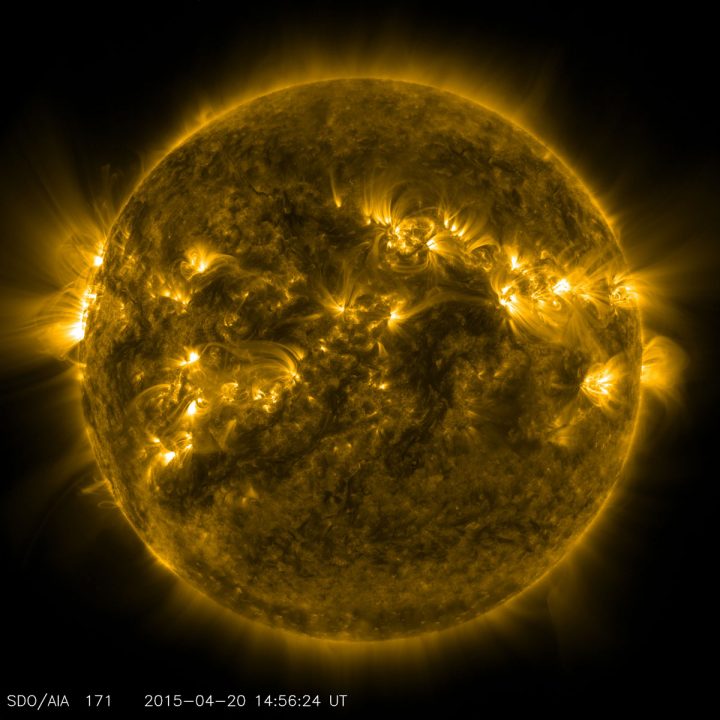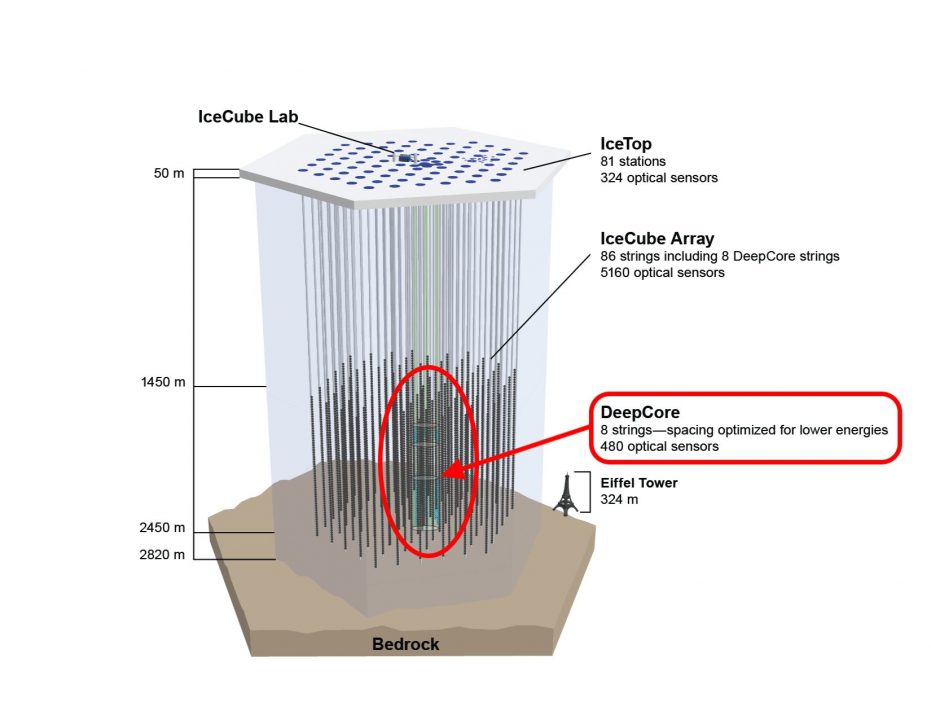Results from the first search for neutrinos coincident with solar flares using IceCube
4 minute read
Although this analysis did not detect any neutrinos from identified solar flares, this result enables an upper bound to be placed on the incident energy of solar flare neutrinos and their flux on Earth. The new low-energy selection developed for this search can also be used in other low-energy neutrino searches in IceCube, such as for neutrinos from compact binary mergers, fast-radio bursts, and novae.

In this image from NASA's Solar Dynamics Observatory, captured on April 20, 2015, bright spots and illuminated arcs of solar material hovering in the sun's atmosphere highlight what are known as active regions on the sun. These are areas of intense and complex magnetic activity that can sometimes give rise to solar eruptions such as solar flares and coronal mass ejections. Credits: NASA/SDO
Solar neutrinos can originate from multiple processes, including fusion in the core, and so far have only been detected in the MeV range. Neutrinos from solar flares have yet to be detected, and would provide a direct probe into proton acceleration — a consequence of the magnetic energy from the flare being converted partially into the kinetic energy of accelerated charged particles. During a solar flare, accelerated protons interact with the dense plasma in the solar atmosphere, resulting in the following processes:
\( p+p \quad \text{or} \quad p+n \rightarrow \begin{cases} \pi^+ + X; & \pi^+ \rightarrow \mu^+ + \nu_\mu; \quad \mu^+ \rightarrow e^+ + \nu_e + \bar{\nu}_\mu \\ \pi^0 + X;& \pi^0 \rightarrow 2\gamma \\ \pi^- + X; & \pi^- \rightarrow \mu^- + \bar{\nu}_\mu; \quad \mu^- \rightarrow e^- + \bar{\nu}_e + \nu_\mu \end{cases}\)
The kinetic energy threshold for these reactions is about 280 MeV, with estimated solar flare neutrino energies ranging up to several GeV. This search focused on solar flares that were bright in gamma rays as detected by Fermi-LAT, specifically those above 100 MeV, such that pion-decay products should dominate. From the gamma-ray observations collected by Fermi-LAT, the proton spectral index can be fitted and used to estimate the neutrino energy distribution and rate. These estimates are highly dependent on the upper cutoff in the accelerated proton spectrum, which previously was unconstrained (see Figure 2 in the published article). Coupling the Fermi-LAT and IceCube observations could constrain the upper cutoff of possible incident solar neutrino energy and the spectral index. Five Fermi-LAT flares were chosen for the analysis.
To understand the backgrounds, several hours of IceCube data were recorded when no solar flare had been detected on either side of the solar disk, for comparison. Various classes of events were simulated to better account for different types of events in the IceCube data in regards to the selection criteria.
Detecting GeV neutrinos in IceCube is no simple feat, however, as IceCube was built to be sensitive to high energy neutrinos, with only the “DeepCore” portion of the detector being sensitive enough to detect neutrinos in the GeV range. To reduce the noise rate, trigger conditions based on coincidences were applied and a data-driven, blind method was created for the analysis. Neutrinos interacting in the water produce a flash of light which can be detected with sensitive light sensors known as digital optical modules (DOMs). The minimum requirement for an event to be considered a candidate was for it to pass the “SMT-3” trigger requirement which requires a coincident signal in each of three close-by DOMs , within \(2.5 \space \rm{\mu s}\). It would then need to pass a set of filters, including removing high energy events \(\geq 5 \space \text{GeV}\), keeping events with preferential direction in pairs of hits, and increasing the purity of the results by applying considerations to charge distribution, depth, centroid of the event, and total charge.
The normal data rate in IceCube is about \(1400 \space \text{Hz}\), and seeing a rare low energy event in that background would be impossible. With the sequence of cuts and filters described above, the background data rate was reduced to \(20 \pm 2 \space \text{mHz}\), with \( 18 \space \text{mHz}\) for pure noise events and all other sources of noise at rates at least one order of magnitude less. Simulations showed that in contrast, 35% of the neutrino signals would be retained. Hence, the signal to noise is greatly enhanced through this analysis.

A schematic of the in-ice portion of IceCube, which includes 86 strings holding 5,160 light sensors arranged in a three-dimensional hexagonal grid. A red ellipse highlights the location of the DeepCore. Credit: IceCube Collaboration
Assuming that the gamma ray and neutrino emission happens simultaneously, an optimal time window was selected within each of the five solar flare events (a period of active gamma observations to further enhance the signal to noise) and the corresponding IceCube data were analyzed. There was no significant signal observed above background, and so an upper limit was placed on the integrated flux of solar flare neutrinos (See Figure 7 in the published article.)
In addition to setting upper limits, this result also demonstrated the feasibility of innovative analyses of IceCube data for low energy neutrinos — events that it was not designed to see. Due to the low energy nature of the events, they are often buried in the IceCube dataset and are of such a high rate that they can not be saved continuously. This analysis necessitated the development of a new alert system which is activated when Fermi-LAT sees a flare, and during that period all data is stored. A dedicated analysis looking for solar flare neutrinos using this new alert system is ongoing. With the implementation of the larger IceCube-Gen2, it is expected that it will have a higher sensitivity and better reconstruction ability. Combined with the tools created in this analysis, and as the Sun is entering its stormy season, it is only a matter of time before the first solar flare neutrino is confirmed.
